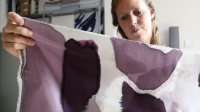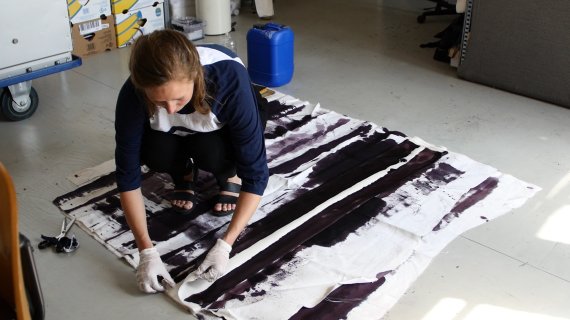Designer Aliki van der Kruijs working with residual ink. © Berber Hania
The dress was design for the occasion by Elsien Gringhuis. What characterises this designer is the timelessness of her designs, which are produced in the Netherlands. Gringhuis: ‘During the first fitting, this dress stood out as it was the one that immediately suited her perfectly. It is one of my classics. The dress is timeless.’ The dress was made of deadstock silk and designed with patterns that waste a minimum amount of material.
Residual ink
Designer Aliki van der Kruijs painted the dress using residual ink. ‘An inkjet printer that is used to dye materials regularly cleans its heads between jobs, to avoid having lines of a different colour. I saw those ink residues on the side of the printer, and they were of a beautiful deep purple hue.’ This ink is normally processed as chemical waste, but Van der Kruijs found a way to reuse this residue, thus lessening the industry’s footprint.

© Berber Hania
Bacterial dye
The shawl was designed and produced by Ilfa Siebenhaar, half of the designer duo Living Colour. The material is organic peace silk, which means that the silkworms are left alive instead of being cooked alive. The designers dyed the shawl using environmentally friendly pigments that are naturally produced by bacteria. These pigments are biodegradable, and no harmful waste is produced in the process. The textile is pure silk, not mixed fibres, and can therefore easily be recycled. Siebenhaar: ‘The bacterial dye is not harmful, and the shawl can be redyed repeatedly, to build seasonal colouring from light to dark, for example.’
Pineapple shoes
Designer Luc Aarts made golden shoes using pineapple leather. Piñatex, as the new material is called, is made from pineapple leaves. This by-product of pineapple culture is a natural and 100% biodegradable alternative to leather. However, the shoes turned out to be a bit too loose. ‘Unfortunately, we had measured the feet during a warm summer day’, Aarts explains. ‘Consequently, the shoes eventually proved somewhat too large.’ The chosen alternative involved using a pair of Fresco’s own shoes and applying Piñatex details.
Fungal leather
The last sustainable detail is the watch strap designed by Iris Houthoff, lecturer in Bio Process Engineering. The strap was made using fungal mycelium, from a Ganoderma lucidum mushroom, to be precise. The mushroom is used throughout Asia to make a bitter medicinal tea. Houthoff: ‘Mycelium grows on residual waste, barely uses any water and is processed using harmless chemicals.’
If you would like to know more about sustainable fashion, read the comprehensive article on circular fashion that will be published in Thursday’s Resource Magazine.
Additional reading (in Dutch):
Schimmeljurken en paddenstoelschoenen
Zo ziet circulaire mode eruit (fotoserie)
WUR organiseert modeshow

